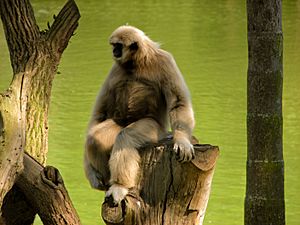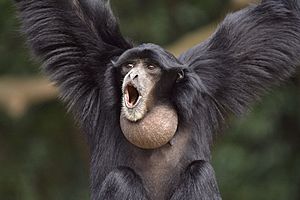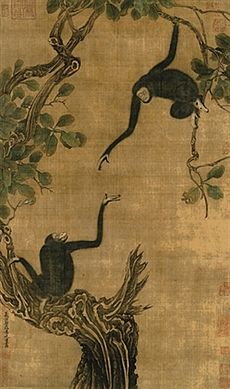Gibbon facts for kids
Quick facts for kids GibbonsTemporal range: Miocene to Recent
|
|
|---|---|
 |
|
| Lar gibbon (Hylobates lar): female left, male right | |
| Scientific classification | |
| Kingdom: | |
| Phylum: | |
| Class: | |
| Order: | |
| Superfamily: | |
| Family: |
Hylobatidae
Gray, 1870
|
| Genera | |
|
Hylobates |
|
Gibbons are a type of ape known for their amazing ability to swing through trees. They are sometimes called "lesser apes." These agile animals live in the forests of Southeast Asia, including places like Sumatra, Thailand, and Malaysia.
Contents
Amazing Tree Travelers

Gibbons are like the best tree travelers in the animal world. They swing from branch to branch so fast, it looks like they are flying! This special way of moving is called brachiation.
Even though they love trees, gibbons can also walk upright on the ground. When they do, they hold their long arms up high. This keeps their arms from dragging on the ground.
Singing in the Forest
Gibbons are also known for their powerful voices. They are like the "singers" of the forest! Their loud calls can travel for many kilometers through the trees.
Sometimes, a male, a female, and their young will sing together. They create a loud chorus. These songs help gibbon families stay in touch with each other. They also tell other animals to stay out of their area.
Male and Female Gibbons
Unlike many other primates, male and female gibbons are usually about the same size. However, their fur color can be different. Males are often black, while females might be a lighter, ash-blond color.
Female gibbons usually have one baby at a time. Gibbons can live for about 25 years.
Physical Features

Gibbons have a special wrist joint. It works like a ball and socket joint. This helps them swing easily through trees. It also saves energy in their arms and shoulders.
They have long hands and feet. There is a deep space between their first and second fingers. Their fur is usually black, gray, or brownish. They often have white markings on their hands, feet, or face.
Some gibbon species have a large throat sac. This sac inflates like a balloon when they call. It makes their voices even louder and more powerful. This sac can sometimes be as big as their head!
Gibbon skulls and teeth are similar to those of great apes. Their noses are like other Old World monkeys and apes.
Gibbon Behavior
Gibbons are social animals. They live in groups and are very protective of their home areas. They defend their space with loud calls and visual displays.
The loud calls can be heard up to 1 kilometer away. Often, a mated pair will sing a duet. Their young sometimes join in. Males and some females also sing alone to find mates. These songs also tell others where their territory is. You can even tell which type of gibbon is singing just by its song!
Gibbons often stay with the same mate for their whole lives. However, they don't always stay with only one partner. Sometimes, mated gibbons even "divorce" and find new partners.
Gibbons are among the best brachiators in nature. Their special wrist joints give them amazing speed and accuracy when swinging. But swinging through trees can be risky. Branches can break or hands can slip. Scientists think that most gibbons break a bone at least once in their lives. They are the fastest and most agile tree-dwelling mammals that don't fly.
What Gibbons Eat
Gibbons mostly eat fruit, which makes up about 60% of their diet. But they also enjoy eating twigs, leaves, insects, and flowers. Sometimes, they even eat bird eggs.
Protecting Gibbons
Most gibbon species are in danger. This is mainly because their forest homes are being destroyed.
On Phuket island in Thailand, there is a Gibbon Rehabilitation Center. Volunteers there rescue gibbons that were kept as pets. They help these gibbons learn to live in the wild again.
In 2015, the IUCN Primate Specialist Group called it the "Year of the Gibbon." They held events around the world to teach people about the problems gibbons face.
Gibbons in Chinese Culture

Long ago, gibbons lived all over central and southern China. Chinese writers often called them "gentlemen" of the forests. This was because gibbons moved gracefully high in the trees. They were seen as noble, unlike macaques who were seen as greedy.
Followers of Taoism believed gibbons had special powers. They thought gibbons could live for hundreds of years and even turn into humans.
Ancient gibbon statues have been found in China, dating back to 400-300 BCE. Later, gibbons became a popular subject for Chinese painters. Artists like Yi Yuanji and Muqi Fachang were famous for painting these apes. The idea of a "gibbon grasping at the reflection of the moon in the water" became popular in Japanese art, even though gibbons don't live in Japan.
Images for kids
-
Northern white-cheeked gibbon, Nomascus leucogenys
-
Agile gibbon, Hylobates agilis
-
Pileated gibbon (Hylobates pileatus)
See also
 In Spanish: Gibones y siamang para niños
In Spanish: Gibones y siamang para niños





